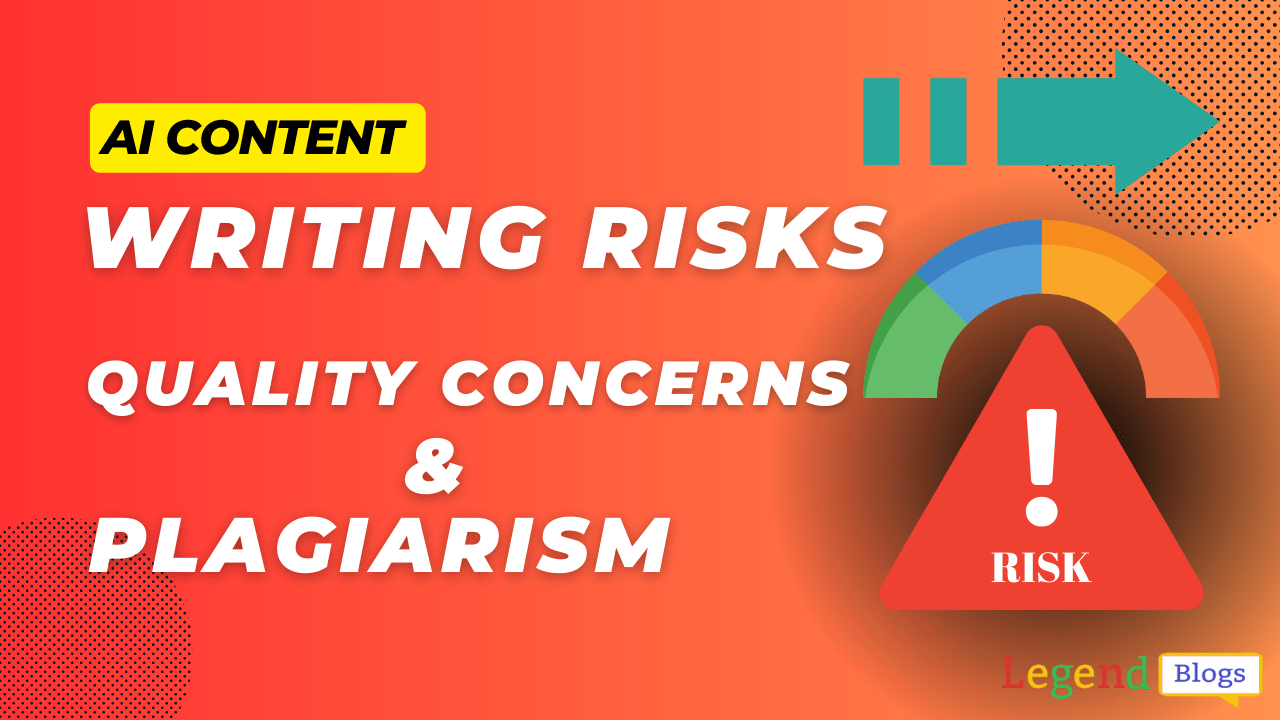In today's digital age, businesses are increasingly turning to AI content writing as a solution to streamline their content creation processes. However, amidst the allure of efficiency and scalability, it's crucial to acknowledge the risks associated with this technology.
One of the biggest risks of AI-generated content is that you're losing authenticity in your content. In this article, we delve into the intricacies of AI content writing, exploring the risks of compromised quality and the looming threat of plagiarism.
Introduction
AI content writing, powered by sophisticated algorithms, has revolutionized the way content is generated. While it promises speed and efficiency, it also raises concerns regarding the authenticity and originality of the content produced. In a landscape where authenticity is paramount, the risks of AI-generated content cannot be overlooked.
Understanding the Risks
Quality Concerns in AI Content Writing
- Lack of Human Touch: AI lacks the nuanced understanding and creativity that human writers bring to the table. As a result, AI-generated content may lack depth and fail to resonate with the audience.
- Potential for Errors and Inaccuracies: Despite advancements in AI technology, it is not immune to errors. Inaccurate information or poorly structured content can undermine the credibility of a brand.
Plagiarism Risks
- Automated Content Duplication: AI content writing tools can inadvertently generate content that closely resembles existing material, leading to unintentional plagiarism.
- Ethical Implications of Plagiarism: Plagiarism not only tarnishes the reputation of a business but also raises ethical concerns regarding intellectual property rights and originality.
Comparisons: Human vs. AI Content Writing
| Aspect | Human Content Writing | AI Content Writing |
|---|---|---|
| Authenticity | Personalized, nuanced, and authentic | Prone to lack authenticity and depth |
| Efficiency | Time-consuming but offers a personalized touch | Efficient and scalable, but may lack originality |
| Adaptability | Can generate content on various topics with ease | Requires human understanding and expertise |
| Quality Control | Human oversight allows for quality assurance | Relies on algorithms, susceptible to errors |
Examples of AI Content Writing Risks
- Instance 1: A clothing brand utilized AI content writing for product descriptions, resulting in generic and unengaging copy that failed to capture the essence of their brand identity.
- Instance 2: An e-commerce platform faced backlash after AI-generated product reviews were flagged for plagiarism, damaging customer trust and brand reputation.
Pros and Cons of AI Content Writing
Pros - AI Content Writing
- Speed and Efficiency: AI content writing enables rapid content creation, ideal for meeting tight deadlines and scaling content production.
- Scalability: AI tools can generate large volumes of content consistently, catering to the demands of content-heavy industries.
- Cost-effectiveness: Automating content creation can lead to cost savings by reducing the need for manual labor.
Cons - AI Content Writing
- Lack of Authenticity: AI-generated content may lack the human touch and authenticity required to connect with audiences on a deeper level.
- Quality Concerns: Despite advancements, AI technology is prone to errors and may produce content of varying quality.
- Plagiarism Risks: Automated content generation increases the risk of unintentional plagiarism, posing legal and ethical challenges.
Addressing Quality Concerns
To mitigate the risks associated with AI content writing, businesses can implement the following strategies:
- Incorporating Human Oversight: Introducing human oversight in the content creation process can ensure that AI-generated content aligns with brand voice and quality standards.
- Implementing Quality Assurance Measures: Regular audits and revisions can help identify and rectify errors in AI-generated content before publication.
- Investing in Training and Development: Continuously refining AI algorithms and providing training on content quality can enhance the authenticity and relevance of AI-generated content.
Mitigating Plagiarism Risks
To combat plagiarism in AI-generated content, businesses can take proactive measures such as:
1. Utilizing Plagiarism Detection Tools
Implementing robust plagiarism detection software can identify and flag instances of duplicate content.
2. Implementing Strict Content Guidelines
Establishing clear guidelines and standards for content creation can discourage plagiarism and promote originality.
3. Educating Writers and Editors
Providing training on ethical writing practices and emphasizing the importance of original content can foster a culture of integrity within the organization.
4. Defining Plagiarism in AI Content
Plagiarism refers to the unauthorized use or replication of someone else's work without proper attribution.
5. Detecting Plagiarized Content
Utilizing plagiarism detection tools and manual review processes can help identify instances of plagiarism in AI-generated content.
6. Preventive Measures against Plagiarism
Implementing strict content guidelines, conducting thorough checks, and fostering a culture of originality can mitigate plagiarism risks.
FAQs (Frequently Asked Questions)
Certainly! Here are the answers to all the FAQs (Frequently Asked Questions):
How does AI content writing differ from human content writing?
AI content writing relies on algorithms to generate content automatically, while human content writing involves personalization and creativity. AI-generated content may lack the emotional intelligence and nuanced understanding that humans bring to the table.
Can AI-generated content be authentic?
While AI can produce content efficiently, it may lack the authenticity and nuance of human-generated content. Authenticity often stems from personal experiences, emotions, and insights that AI algorithms may struggle to replicate.
What are the main quality concerns associated with AI content writing?
Quality concerns in AI content writing include the lack of human touch, potential for errors and inaccuracies, and difficulty in capturing the nuances of language and context. AI-generated content may also lack originality and fail to resonate with the intended audience.
How prevalent is plagiarism in AI-generated content?
Plagiarism in AI-generated content can occur due to automated content duplication and the reuse of existing material without proper attribution. While plagiarism rates may vary depending on the quality of AI algorithms and content sources, businesses must remain vigilant in detecting and addressing instances of plagiarism.
What measures can businesses take to ensure the authenticity of AI-generated content?
To ensure the authenticity of AI-generated content, businesses can implement human oversight, quality assurance measures, and training programs. Human oversight involves reviewing and refining AI-generated content to align with brand voice and quality standards.
Quality assurance measures include regular audits and revisions to identify and rectify errors. Training programs can help AI models learn from human feedback and improve the relevance and authenticity of generated content.
Are there any legal consequences of using AI-generated content that is plagiarized?
The use of plagiarized content, whether generated by AI or created by humans, can lead to legal consequences such as copyright infringement and intellectual property disputes. Businesses may face lawsuits, fines, and damage to their reputation if they are found to be using plagiarized content without proper authorization or attribution.
How can AI content writing be improved to address quality concerns?
AI content writing can be improved by refining algorithms to better understand language nuances and context, incorporating feedback mechanisms for continuous learning, and enhancing content generation capabilities to prioritize originality and authenticity. Additionally, collaborations between AI developers, content creators, and subject matter experts can help bridge the gap between technology and human creativity.
What role does human oversight play in mitigating the risks of AI content writing?
Human oversight is essential in mitigating the risks of AI content writing by ensuring that generated content meets quality standards, aligns with brand voice and messaging, and adheres to ethical guidelines. Human oversight involves reviewing, editing, and refining AI-generated content to enhance its relevance, authenticity, and engagement.
Are there any industries where AI content writing poses higher risks?
Industries that prioritize authenticity, creativity, and personalized communication, such as marketing, journalism, and content creation, may face higher risks with AI content writing. Additionally, sectors that deal with sensitive or regulated information, such as healthcare and finance, must exercise caution to ensure the accuracy and integrity of AI-generated content.
What are the ethical considerations when using AI-generated content?
Ethical considerations when using AI-generated content include transparency in disclosure of AI involvement, respect for intellectual property rights and copyright laws, protection of user privacy and data security, and accountability for the impact of AI-generated content on individuals and society. Businesses must uphold ethical principles and standards in AI content creation to build trust with their audience and stakeholders.
Conclusion
In conclusion, while AI content writing offers unparalleled efficiency and scalability, businesses must navigate the risks of compromised quality and plagiarism. By incorporating human oversight, implementing quality assurance measures, and prioritizing ethical content creation, businesses can harness the power of AI while preserving the authenticity of their content. Your thoughts matter!
Feel free to share your experiences and insights on AI content writing in the comments section below.







Write a comment